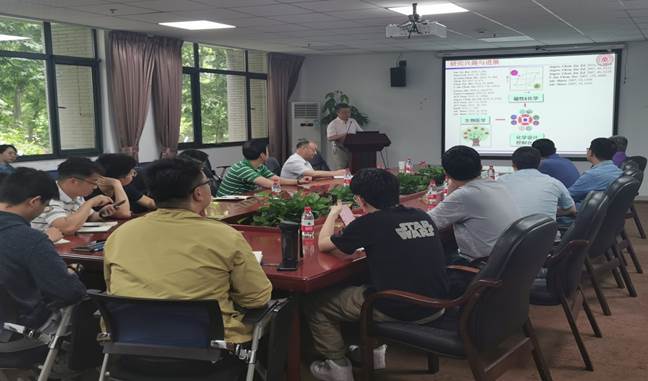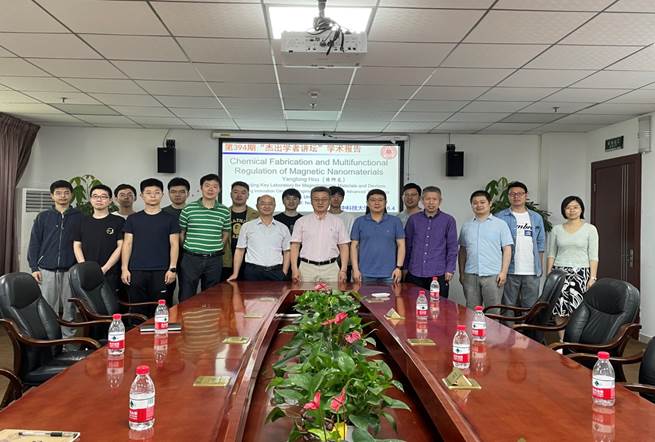2021年06月04日上午10点,北京大学侯仰龙教授应开云手机入口李箐教授邀请,在我校先进制造大楼西楼C306会议室进行讲座,题为“磁性纳米材料的化学构建与多功能调控”。

侯仰龙教授,北京大学博雅特聘教授,皇家化学会会士(FRSC),国家重点研发计划纳米科技专项首席科学家,磁电功能材料与器件北京市重点实验室主任。主要从事多功能磁性材料、新能源材料的控制合成及其在纳米生物医学与能源领域的应用探索研究。发展了单分散磁性纳米材料的通用制备方法,探索了磁性纳米颗粒在肿瘤等重大疾病的诊断与治疗的应用;设计制备了若干纳米结构杂化材料用于高性能的锂电池电极等。迄今发表学术论文190余篇,引用18000余次,H因子71。申请专利16项,授权12项。2019年获国家自然科学二等奖1项。荣获全国创新争先奖状、北京茅以升青年科技奖、中国化学会-英国皇家化学会青年化学奖。曾获全国优秀科技工作者和科睿唯安高被引科学家(2018, 2019, 2020)。在国际和各类双边会议上作大会或分会邀请报告80余次。正主持国家重点研发计划,国家自然科学基金委重大科研仪器研制、重点项目等。现任Rare Metals副主编,Advanced Science、Science China Material期刊编委,中国化学会理事、青年委员会主任委员等。

Magnetic nanomaterials (MNMs) have attracted great interests in the past few decades due to their unique properties and novel physical effects resulted from nanoscale. To understand the fundamental behavior of nanomagnetism and develop relevant potential applications, various preparation routes have been explored to produce MNMs with desired features and structures, among which chemical synthesis process, especially high-temperature organic liquid phase method, plays an indispensable role in which the microstructures and physical/chemical properties of MNMs can be tuned by controlling the reaction conditions such as precursor, surfactant, solvent, reaction temperature or time, protection atmosphere, etc. In this talk, we first introduce the fundamental of high-temperature organic liquid phase method, and present recent progress on the synthesis of various of MNMs, including monocomponent nanostructures (like metals, metal alloys, metal oxides/carbides) and multicomponent nanostructures (heterostructures and exchange-coupled nanomagnets). Particularly, the latter type not only retains the intrinsic functionalities from each single component, but also possesses the synergistic properties that benefitted from interfacial coupling, improving magnetic, optical or catalytic features. After that we will discuss the multifunctional regulations of MNMs in biomedicine and catalysis. Except of conventional MNMs, i.e. Fe3O4, one kind of representative iron carbides, have exhibited multifunctional properties. On the one hand, iron carbide NPs hold magnetic characteristic, can be employed as magnetic courtpart for as contract agents for T2-weighted MRI and photoacoustic imaging (PAI) even for photothermal therapy (PTT) under NIR irradiation for ablating tumors effectively. To enhance cancer therapeutic efficiency, anticancer drug doxorubicin is loaded into bovine serum albumin coated iron carbide NPs, combining PTT with chemotherapy. Such nanoplatform can respond to NIR and acidic environments, and exhibit burst drug release. On the other hand, one kind of iron carbides, Fe5C2 NPs exhibited excellent catalytic performance for the Fischer−Tropsch synthesis, either in efficiency or selectivity. In summary, we overview the rational design, fabrications of magnetic nanomaterials, and give perspectives in great potential applications of these materials in biomedicine and nanocatalysis.
